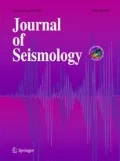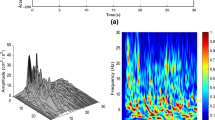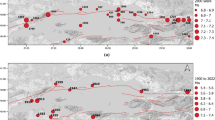Abstract
The earthquakes in Uttarkashi (October 20, 1991, M w 6.8) and Chamoli (March 8, 1999, M w 6.4) are among the recent well-documented earthquakes that occurred in the Garhwal region of India and that caused extensive damage as well as loss of life. Using strong-motion data of these two earthquakes, we estimate their source, path, and site parameters. The quality factor (Q β ) as a function of frequency is derived as Q β (f) = 140f 1.018. The site amplification functions are evaluated using the horizontal-to-vertical spectral ratio technique. The ground motions of the Uttarkashi and Chamoli earthquakes are simulated using the stochastic method of Boore (Bull Seismol Soc Am 73:1865–1894, 1983). The estimated source, path, and site parameters are used as input for the simulation. The simulated time histories are generated for a few stations and compared with the observed data. The simulated response spectra at 5% damping are in fair agreement with the observed response spectra for most of the stations over a wide range of frequencies. Residual trends closely match the observed and simulated response spectra. The synthetic data are in rough agreement with the ground-motion attenuation equation available for the Himalayas (Sharma, Bull Seismol Soc Am 98:1063–1069, 1998).

















Similar content being viewed by others
References
Aki K (1980) Attenuation of shear waves in the lithosphere of frequencies from 0.05 to 25 Hz. Phys Earth Planet Interiors 21:50–60
Atkinson GM (1984) Attenuation of strong ground motion in Canada from a random vibration approach. Bull Seismol Soc Am 74:2629–2653
Atkinson GM (2004) Empirical attenuation of ground-motion spectral amplitudes in southeastern Canada and the northeastern United States. Bull Seismol Soc Am 94:1079–1095
Atkinson GM, Boore DM (1995) Ground motion relations for eastern North America. Bull Seismol Soc Am 85:17–30
Atkinson GM, Boore DM (2006) Earthquake ground-motion prediction equations for eastern North America. Bull Seismol Soc Am 96:2181–2205
Atkinson GM, Cassidy J (2000) Integrated use of seismograph and strong motion data to determine soil amplification in the Fraser delta: results from Duvall and Georgia state earthquakes. Bull Seismol Soc Am 90:1028–1040
Beresnev IA, Atkinson GM (2002) Source parameters of earthquakes in eastern and western North America based on finite-fault modeling. Bull Seismol Soc Am 92:695–771
Boore DM (1983) Stochastic simulation of high-frequency ground motions based on seismological models of the radiated spectra. Bull Seismol Soc Am 73:1865–1894
Boore DM (1986) The effect of finite bandwidth on seismic scaling relationships. In: Das S, Boatwright J, Scholz C (eds) Earthquake source mechanics, geophysical monograph 37. American Geophysical Union, Washington DC, pp 275–283
Brune JN (1970) Tectonic stress and the spectra of seismic shear waves from earthquakes. J Geophys Res 75(26):4997–5009
Brune JN (1971) Corrections. J Geophys Res 76(26):6488
Chandrasekaran AR, Das JD (1992) Analysis of strong motion accelerogram of Uttarkashi earthquake of October 20, 1991. Bull Indian Soc of Earthq Tech 29(1):35–55
Dewey JF, Bird JM (1970) Mountain belts and new global tectonics. J Geophys Res 75:2625–2647
Frankel A (1995) Simulating strong motions of large earthquakes using recordings of small earthquakes—the Loma Prieta main-shock as a test case. Bull Seismol Soc Am 85:1144–1160
Gupta SC, Kumar A (2002) Seismic wave attenuation characteristics of three Indian regions: a comparative study. Curr Sci 82:407–413
Gupta SC, Teotia SS, Rai SS, Gautam N (1998) Coda Q estimates in the Koyna region, India. Pure and Appl Geophys 153:713–731
Gupta SC, Singh VN, Kumar A (1995) Attenuation of coda waves in the Garhwal Himalaya, India. Phys of Earth and Planet Interiors 87(3):247–253
Hanks TC, McGuire RK (1981) The character of high frequency strong ground motion. Bull Seismol Soc Am 71:2071–2095
Hermann RB (1985) An extension of random vibration theory estimated of strong ground motion to large distances. Bull Seismol Soc Am 75:1447–1553
Huang CH, Teng TL (1999) An evaluation of H/V ratio vs. spectral ratio for the site-response estimation using the 1994 Northridge earthquake sequences. Pure and App Geophys 156:631–649
Joshi A (2004) A simplified technique for simulating wide-band strong ground motion for two recent earthquakes. Pure and App Geophys 161:1777–1805
Joshi A (2006) Use of acceleration spectra for determining the frequency dependent attenuation coefficient and source parameter. Bull Seismol Soc Am 96:2165–2180
Khattri KN, Chander R, Gaur VK, Sarkar I, Kumar S (1989) New seismological results on the tectonics of the Garhwal Himalaya. Proc Indian Acad Earth Planet Sci 98:91–109
Kumar N, Parvez IA, Virk HS (2004) Estimation of coda waves attenuation for NW Himalayan region using local earthquakes, research report CM-0404, C MMACS, India
Kumar D, Sarkar I, Sriram V, Khattri KN (2005) Estimation of the source parameters of the Himalaya earthquake of October 19, 1991, average effective shear wave attenuation parameter and local site effects from accelerogram. Tectonophysics 407:1–24
Langston CA, Chi Chiu SC, Lawrence Z (2010) Array observations of micro-seismic noise and the nature of H/V in the Mississippi embayment. Bull Seismol Soc Am 99(5):2893–2911
Le fort P (1975) Himalaya, the collided range. Am J Sci 278:1–44
Lermo L, Chavez-Garcia FJ (1993) Site effect evaluation using spectral ratio with only one station. Bull Seismol Soc Am 83:1574–1594
Mandal P, Rastogi BK (1998) A frequency-dependent relation of coda Qc for Koyna Warna region, India. Pure Appl Geophys 153:163–177
Molnar P, Tapponnier P (1975) Cenozoic tectonics of Asia: effect of continental collision. Science 489:419–426
Motazedian D, Atkinson GM (2005) Stochastic finite-fault modeling based on dynamic corner frequency. Bull Seismol Soc Am 95(3):995–1010
Motazedian D (2006) Region specific key seismic parameters of earthquakes in northern Iran. Bull Seismol Soc Am 96:1383–1395
Nakamura Y (1989) A method of dynamic characteristics estimation of subsurface using micro-tremor on the ground surface. Quarterly Report on Railroad Research 30:25–33
Narula PL (1992) Neo-tectonic activity, seismicity and related contemporary deformation in the NW Himalaya. Intl Symp on Himalayan Geology, Shimate, Japan, pp 33–36
Paul A, Gupta SC, Pant CC (2003) Coda Q estimate from Kumaon Himalaya. Proc Ind Acad Soc Earth Planet Sc 112:569–678
Schnabel PB, Lysmer J, Seed HB (1972) A computer program of earthquake response analysis of horizontally layered sites. Report no. EERC72-12, University of California, Berkeley
Sharma ML (1998) Attenuation relationship for estimation of peak ground horizontal acceleration using data from strong motion arrays in India. Bull Seismol Soc Am 98:1063–1069
Seeber L, Armbruster JG (1981) Great detachment earthquakes along the Himalayan arc and long term earthquake prediction: an international review. American Geophysical Union, Washington, DC, pp 259–277
Silva W, Gregor N, Darragh R (2002) Department of Regional Hard Rock Attenuation Relations for Central and Eastern North America. ftp://ftp.pacificengineering.org/CEUS/
Singh SK, Ordaz M, Dattatrayam RS, Gupta HK (1999) A spectra analysis of the 21 May 1997, Jabalpur, India earthquake (Mw 5.8) and estimation of ground motion from future earthquakes in the Indian shield region. Bull Seismol Soc Am 89(6):1620–1630
Singh SK, Garcia D, Pacheo JF, Valenzuela R, Bansal BK, Dattatrayam RS (2004) Q of Indian shield. Bull Seismol Soc Am 94:1564–1570
Suzuki T, Adachi Y, Tanaka M (1995) Application of micro tremor measurement to the estimation of earthquake ground motion in Kushiro City during the Kushiro-Oki earthquake of 15 January 1993. Earthq Eng Struct Dyn 24:595–613
Thakur VC (1993) Geology of Western Himalaya. Pergman, Oxford, p 355
Thakur VC, Kumar S (1995) Seismotectonics of the 20 October 1991 Uttarkashi earthquake in Garhwal Himalaya, North India. Memoir Geol Soc of India 30:101–108
Theodulis NP, Bard PY (1995) Horizontal to vertical spectral ratio and geological conditions: an analysis of strong motion data from Greece and Taiwan (SMART-1). Soil Dyn Earthq Eng 14:177–197
Toro GR, McGuire RK (1987) An investigation into earthquake ground motion characteristics in the eastern North America. Bull Seismol Soc Am 77:468–489
Valdiya KS (1988) Tectonics and evolution of the central sector of the Himalaya. Phil Trans Roy Soc London A 326:801–803
Vladimir Yu, Sokolov Chin-Hsiung Loh, Jean Wen-Yu (2007) Application of horizontal to-vertical (H/V) Fourier spectral ratio for analysis of site effect on rock (NEHRP-class B) sites in Taiwan. Soil Dyn and Earthq Eng 27(4):314–323
Yu G, Khattri KN, Anderson JG, Brune JN, Zeng Y (1995) Strong ground motion from the Uttarkashi, Himalaya, India Earthquake: comparison of observation with synthetics using the composite source model. Bull Seismol Soc Am 85:31–50
Acknowledgments
Thanks are due to anonymous reviewers for their constructive comments and suggestions for improving the article. We are also thankful to the Department of Earthquake Engineering, IIT Roorkee and the Indian Meteorological Department for providing Earthquake data. The support of the Centre of Excellence in Disaster Mitigation & Management, IIT Roorkee is gratefully acknowledged.
Author information
Authors and Affiliations
Corresponding author
Additional information
An erratum to this article can be found at http://dx.doi.org/10.1007/s10950-011-9259-2.
Rights and permissions
About this article
Cite this article
Harbindu, A., Sharma, M.L. & Kamal Stochastic ground-motion simulation of two Himalayan earthquakes: seismic hazard assessment perspective. J Seismol 16, 345–369 (2012). https://doi.org/10.1007/s10950-011-9247-6
Received:
Accepted:
Published:
Issue Date:
DOI: https://doi.org/10.1007/s10950-011-9247-6




